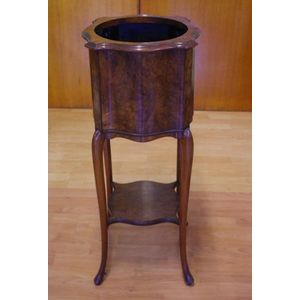Chinese Marble Inlaid Rosewood Table, Qing Dynasty
A Chinese marble rosewood and Mother-of-pearl inlaid table, Qing Dynasty, late 19th to early 20th century, the round waisted table with an inset marble top with red and cream blooms, bordered with auspicious bird, floral and dentil decorations, the prolifically carved apron with lingzhi fungus motifs enclosing symbolic creatures, raised on monumental legs with claw feet united by a shaped stretcher, height 81 cm, diameter 97 cm
You must be a subscriber, and be logged in to view price and dealer details.
Subscribe Now to view actual auction price for this item
When you subscribe, you have the option of setting the currency in which to display prices to $Au, $US, $NZ or Stg.
This item has been sold, and the description, image and price are for reference purposes only.
- Mother-Of-Pearl - Mother-of-pearl, technical name "nacre", is the inner layer of a sea shell. The iridescent colours and strength of this material were widely used in the nineteenth century as an inlay in jewellery, furniture, (especially papier mache furniture) and musical instruments.
In the early 1900s it was used to make pearl buttons. Mother-of-pearl is a soft material that is easily cut or engraved.
Nowadays it is a by-product of the oyster, freshwater pearl mussel and abalone industries. - Qing Dynasty - The Qing Dynasty was the last imperial dynasty of China, ruling from 1644 to 1912. It was established by the Manchu people, who originated from the northeastern region of China. The Qing Dynasty was preceded by the Ming Dynasty and followed by the Republic of China.
- Rosewood - A dense timber that varies in shade to very light brown to almost black. When rosewood is cut and sanded the colour of the timber will turn black, and after polishing and exposure to daylight, the surface will gradually lighten over time to light brown with black streaks.
The name comes from the odour emanating from the timber when it is planed, sanded or cut.
Rosewood was very popular for use in Victorian furniture in the second half of the 19th century, and at that time most of the rosewood was imported from Brazil. However it also grows in India and Indonesia.
It is used in the sold for chairs and table legs, but for carcase furniture such as side cabinets and bookcases, and for table tops it is always used as a veneer. - Ming Dynasty - The Ming Dynasty was a ruling dynasty of China from 1368 to 1644. It succeeded the Yuan Dynasty and preceded the Qing Dynasty. The Ming Dynasty was established by Zhu Yuanzhang, a former Buddhist monk who became a rebel leader and eventually overthrew the Mongol Yuan Dynasty. During the Ming Dynasty, China experienced a period of relative stability and prosperity. The government was centralized and bureaucratic, with the emperor at the top of the hierarchy. The Ming Dynasty is known for its cultural achievements, including the development of porcelain, the invention of movable type printing, and the construction of the Great Wall of China.
This item has been included into following indexes:
- Chinese furniture, chairs
- Chinese furniture, tables - tables and chairs, marble and mother of pearl inlay or inset 164
- furniture, period or style - oriental 1,724
Visually similar items

A French Louis XV style oval walnut and floral marquetry side cabinet with brass gallery. 66 cm high.
Sold by
in
for
You can display prices in $Au, $US, $NZ or Stg.

A pair of French Kingwood marquetry inlaid two drawer bedside chests, having shaped marble tops and ormolu mounts. 73 cm high, 33 cm long, 33 cm depth
Sold by
in
for
You can display prices in $Au, $US, $NZ or Stg.

Two Japanese marble top low tables, 38 cm and 39 cm high
Sold by
in
for
You can display prices in $Au, $US, $NZ or Stg.

Burr walnut jardiniere plant stand, circa 1920s, 89 cm high
Sold by
in
for
You can display prices in $Au, $US, $NZ or Stg.
